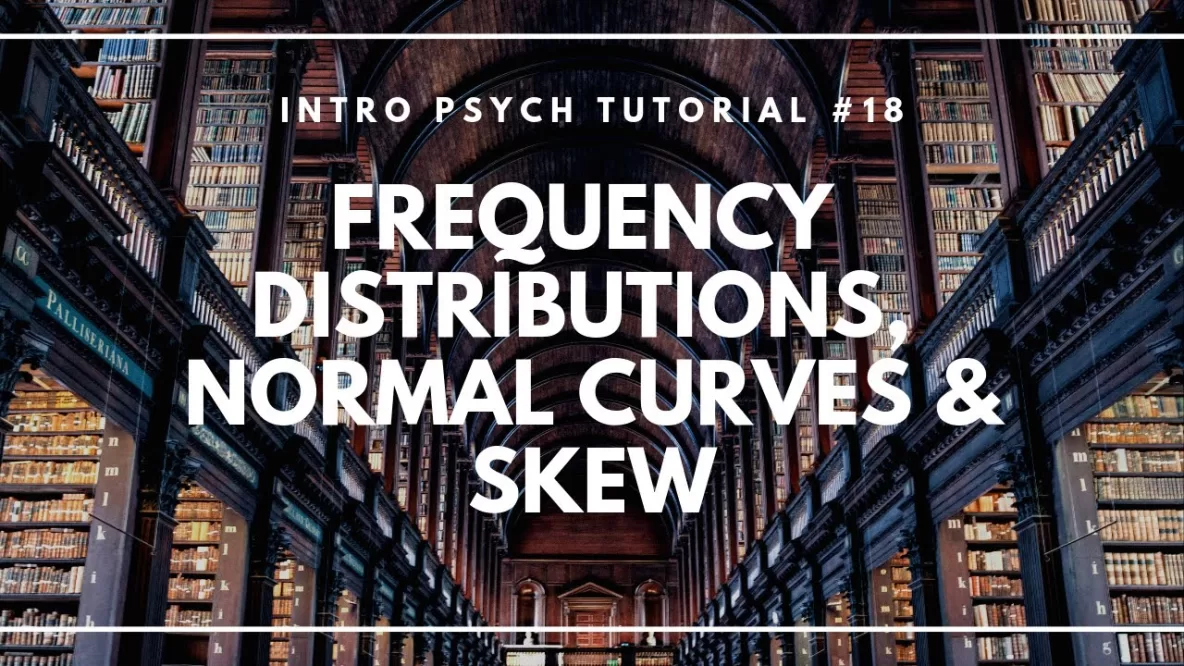In this video I explain how a frequency distribution can create a visual representation of our data. I also describe a normal curve or “bell curve” and what it means for mean, median, and mode. Then I consider skewed distributions with positive or negative skew.
Don’t forget to subscribe to the channel to see future videos! Have questions or topics you’d like to see covered in a future video? Let me know by commenting or sending me an email!
Need more explanation? Check out my full psychology guide: Master Introductory Psychology: http://amzn.to/2eTqm5s
Video transcript:
Hi, I’m Michael Corayer and this is Psych Exam Review and in this video I’m going to talk about frequency distributions, normal curves, and skew. So, what’s a frequency distribution? Well, this just refers to a graph that tells us the frequency of each of the scores in our distribution. So we’re going to have the frequency here on the Y axis and then we’re going to have the score on the X axis and what we do as we look at each score and we just ask how frequent was it?
How many people got this score, how many people got this score? That’s going to give us a depiction of our data. Now what I’ve tried to draw here is a normal curve or a “bell curve”
A normal curve or a bell curve refers to the situation where ur scores make this symmetrical bell-shaped pattern here the most frequently occurring score is here in the middle and the scores are evenly divided mongst each side. So we have 50% of the scores over here and 50% of the scores on the other side. What does it mean when we have a normal curve? Let’s think about our measures of central tendency so our mode, our most frequent score, is going to be here, it’s going to be the peak on this graph and that’s always going to be the mode when we look at a frequency distribution. The peak is always to be the most frequent score.
Alright, here it is here. That’s the most frequent and so whatever this score is here, that’s going to be our mode.
How about our median? Well a median is the middle score and if these are symmetrical and 50% are on this side and 50% are on this side, well then right here in the middle is going to be our middle score, it’s going to be our median. It’s going to fall exactly in the middle of our distribution.
And how about our mean? Well, if these are symmetrical then they’re going to balance each other out and the mean is going to end up also exactly in the middle. So if we have a normal curve then we know that our mean, our median, and our mode, are all going to be at the same point on our graph. We’ll talk more about what a normal curve means when we look at intelligence.
But of course all of our data isn’t going to fall into a normal curve. Let’s take an example that you were taking a test in school and let’s say that this was an easy test. So what’s our data going to look like if we have an easy test? Well let’s say this is the maximum score here, 100 on the test, and let’s say that many students were able to get 100 on this test because it was easy. And most students made 1 or 2 mistakes so the most common score is going to be a little below 100 and then everybody was pretty there and if we go lower than that we see very few scores but a couple students did very poorly on the test. They weren’t prepared at all.
So what’s going to happen here? Well, where’s our mode going to be? As I said before it’s always going to be the peak on our graph, so our mode is going to be here. But what’s going to happen is that these extreme low scores here are going to influence our mean. They’re not going to influence our mode but they’re going to pull our mean in that direction.
Because we said before the mean is sensitive to extreme scores. One student gets a 10 on this test and suddenly the average is going to drop by several points. So what happens is the mean ends up over here, somewhere to the left of the mode. It gets pulled in this negative direction. So we call this negative skew.
So the skew refers to which direction is being pulled here, it’s being pulled down, so this is negative skew. On the other hand, we might take a test that’s the hard test and what happens when we have a really hard test?
Well, let’s say here is, you know, 60, let’s say lots of students got a 60 on this test. Some students scored below that but most students got a 60 on this test or somewhere close to that but a couple students were really well prepared and they got very high scores, 95, 100 something like that.
So what’s going to happen in this distribution? Well, again, our mode is going to be here at the peak but this time our mean is going to be get pulled, these high scores over here, the student who earned 100, is going to pull the average up. So the mean is going to end up somewhere to the right of the mode in this case. Pulled in this direction and this is referred to as positive skew.
Ok, so that’s frequency distributions, normal curves, and skew. I hope you found this helpful. If so, please like the video and subscribe to the channel for more.
Thanks for watching!

